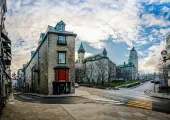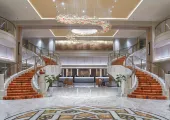Ancient Architecture of Huipai 7 Must See Architectural Sites of Wuyuan
Xiaojiang Ancestral House: the first of the four ancient buildings in Wuyuan Xiaojiang Ancestral Hall, also known as Yongsi shrine, was built in the 6th year of Wanli, Emperor of the Ming Dynasty. It is located in Jiangwan Town, Wuyuan County. Xiaojiang Ancestral House was known as the "best ancestral temple" among the 70 famous ancestral temples in the south of the Yangtze River. The first of the ancient buildings is the symbol of Jiangwan Scenic Spot. The Xiao Clan is the largest family in Jiangwan. The first ancestor was Xiao He in the Western Han Dynasty. He was also an ancestor of Jiang Zemin. One time Jiang Zemin went to Jiangwan to worship the ancestors in Xiaojiang Temple. The Xiaojiang Temple is large with exquisite wood carvings. It’s very rare in China.
Rainbow Bridge: Go to the most beautiful bridge in China Rainbow Bridge is located within the borders of Qinghua Town. It was built during the Song Dynasty. It is named after the Tang poetry "Two Waters with a Mirror and a Double Bridge Rainbow". It is the oldest and longest bridge in ancient Huizhou. It was praised in the media as "One of the most beautiful corridor bridges in China." In addition, there is the center of "Sparkling Red Star", Pan Dongzi sitting in a boat singing "Little Bamboo Raft”. The Rainbow Bridge is built on the widest river. The bridge pier has a special half-boat shape that is pointy in front and flat in the back. It’s for breaking down the force of water flow. For more than 800 years, Rainbow Bridge has not suffered serious damage. There is a horizontal inscribed board on the pavilion of the bridge, where four big characters are written: “long rainbow after a storm". In the shrine the ancestor is worshipped who built the bridge and Dayu, the one who rebuilt it and built the ancient water control.

Yu Clan Temple: A Treasure of Chinese Woodcarving Art Yu Clan Temple is located in Wangkou Village of Wuyuan. Yu Clan Temple was built in the 9th year of the Qing Dynasty. It is the most well-known ancient building in the village. It is famous for its exquisite wood carvings. It is also known as the first shrine in Jiangnan. The Qing-dynasty-style axis with a saddle roof type construction has been hailed as a treasure house of ancient architectural experts’ architectural art. There are meticulous wooden carvings everywhere in the interior of the temple. It is very beautiful, there are more than a hundred sets of carvings such as shallow carvings, deep carvings, round carvings, and transparent carvings of dragons and phoenixes, qilin unicorns, pine cranes, white deer, a balcony of water pavilion protagonists, beasts of the field and birds of the sky, bluegrass flowers and so on.
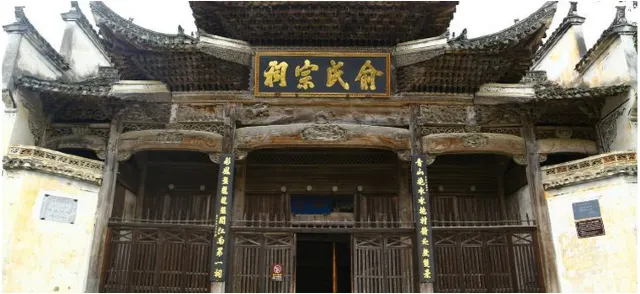
Baishou Reception Pavilion: an ancient house formed with a hundred “shou” Baishou Reception Pavilion is located in Sixiyan Village of Wuyuan County. It’s named Baishou Reception Pavilion, because the whole building is carved with the word "shou" in 99 different calligraphic fonts. The last "shou" carving is the composition of the whole house, it can be seen from the sky as well. Baishou Reception Hall was originally the state guesthouse of Chengzhitang. It was built during Jiaqing Emperor’s period and is one of the emblems of Huizhou architecture. The genuine wood carvings have very exquisite and magnificent craftmanship.
Tongji Bridge: Wind and Rain Bridge from Ming Dynasty Tongji Bridge is located at the entrance of Sixi Village in Wuyuan, above Sishui County. It was built during the Ming Dynasty. There is a Fengyu Gallery Bridge. Although it is smaller than the near Rainbow Bridge, but “Tongji Bridge” and the “Tathagata Buddha Pillar” on the bridge are the legacy of the water cascade of the ancient village, At the time of construction of Tongji Bridge, the villagers of Sixi Village raised the money for construction. After the completion it was not only a resting and chatting place for villagers, but it also became the “News location” for the whole village. There are many kinds of major and minor events in the village, and the surrounding view is also very beautiful, with the flavor of countryside life.
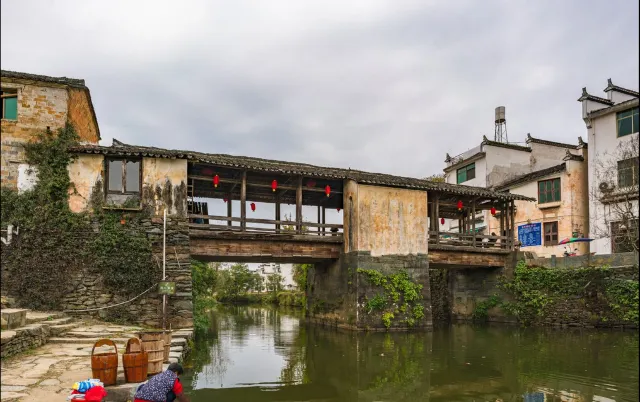
Jing Xu Tang: Built in accordance with the original text of "Ghost Story" Located in the scenic area of Sixi-Yancun, Jing Xu Tang is the most perfectly preserved trading house in Yancun. During the construction, the owner of the house followed the description of "Ghost Story" without modification, and built "Jing Xu Tang" which covers an area of three mu. Three hundred years later, numerous shots of the TV series "Ghost Story" were shot here. Jing Xu Tang was built during the period of Yongzheng Emperor, and occupies an area of one mu. It consists of a courtyard, a guest hall, a back hall, a reception pavilion, a park and so on. There are beautiful wood carvings in the main hall, paintings hanging on the walls, delicate wood carvings in the reception pavilion, and the huge bells, the flower vase, mirror arranged on the table are called "Eastern Vase,Western Mirror" which is homophonic to "Dongping Xijing", which means, no matter if you walk east or rush to the west, you can be peaceful and quiet.
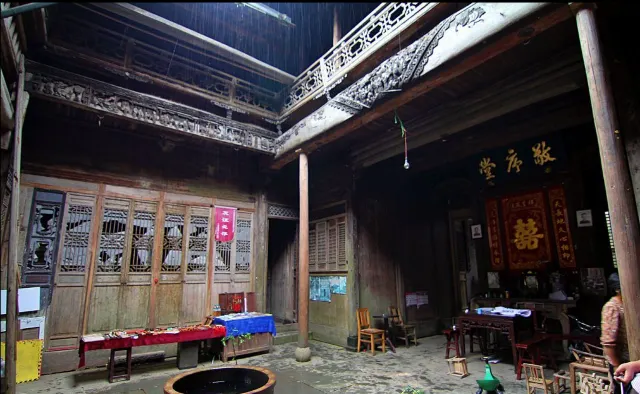
Baizhu Temple: the fusion of the royal and the Huizhou style Baizhu Temple is also known as Jingyi Hall. It is located on the only road that leads to the north part of Wuyuan. The name of “Hundred Pillars Ancestral Hall” originates from the 99 pillars in the ancestral hall. It is a huge fusion of Huizhou and royal architecture. It has even been described as a "private golden temple." In a legend it is said that in the beginning of the construction of the clan’s shrine, there were nine steps in front of the arched gate of the hall, called “Nine Steps on Golden Stairs”, and there are 99 pillars in the Ancestral Hall. On the girders, there are patterns such as “Turtle and fish Spitting Clouds” and “Lucky symbol of dragon and phoenix”. The carving is completely delicate, and the four stone foundations are deeply decorated with the "Heron Opera Lotus", "Feng Opera Peony", "Red-crowned Crane Cloud" and "Magpie Plumflower". After the defendant secretly said to Huangcun "Build the Golden Temple privately", there was an intention to plot a rebellion, thereupon he changed the nine-level step into seven levels. In order to mix the quantity up, the ancestral hall was named as "Hundred Pillar Ancestral Temple."

Trending Travelogues
Popular Trip Moments
Popular Travel Types
Popular Attractions
Popular Ranked Lists
Popular Destinations
Recommended Attractions at Popular Destinations







Site Operator: Trip.com Travel Singapore Pte. Ltd.
